NiftyOne is a platform for bulk visualization of large-scale neuroimaging datasets, leveraging features of FiftyOne with popular neuroimaging python packages.
Installation
tip
For stability, NiftyOne should be installed in its own environment. For example, to
install NiftyOne using virtualenv:
python -m venv niftyone
source niftyone/venv/activate
NiftyOne can be installed using pip:
pip install -U pip
pip install git+https://github.com/childmindresearch/niftyone.git
important
FFmpeg is a non-Python dependency required for NiftyOne. Please refer to their documentation for installation instructions.
Usage
To get started, try using the boilerplate command:
niftyone <bids_directory> <output_directory> <analysis_level>
tip
To see all arguments, run:
niftyone --help
Quick-start
-
Generate figures for each participant
niftyone <bids_directory> <output_directory> participant -
Collect participant figures into a compatible dataset
niftyone <bids_directory> <output_directory> group -
Launch FiftyOne app
niftyone <bids_directory> <output_directory> launch
Contributing
Contributions to NiftyOne are welcome! Please refer to the Contributions page for information on how to contribute, report issues, or submit pull requests.
License
NiftyOne is distributed under the MIT license.
Support
If you encounter any issues or have questions, please open an issue on the issue tracker.
Installation
To install niftyone, you can use your installer of choice (e.g. pip, pipx, uv,
etc). For example, to install the application with pip, use the following command:
pip install git+https://github.com/childmindresearch/niftyone
tip
Replace pip with your installer of choice.
If installed properly, you should be able to run the following in your terminal:
niftyone -h
note
For external dependencies, please refer to their respective documentation pages.
Features
Some features of NiftyOne include:
- Figure generation for QC
- Aggregation of QC metrics
- Shareable QC annotations
Figure Generation
NiftyOne can generate figures and videos for BIDS datasets for QC purposes using popular Python libraries, such as nibabel, numpy, etc. Possible outputs include:
General / anatomical
- Three view - a static image for a given volume in the three anatomical orientations (coronal, axial, sagittal)
- Slice video - a video slicing through a single orientation for a given volume
- Three view video - a video slicing through the 4th dimension (e.g. time) in the three anatomical orientations
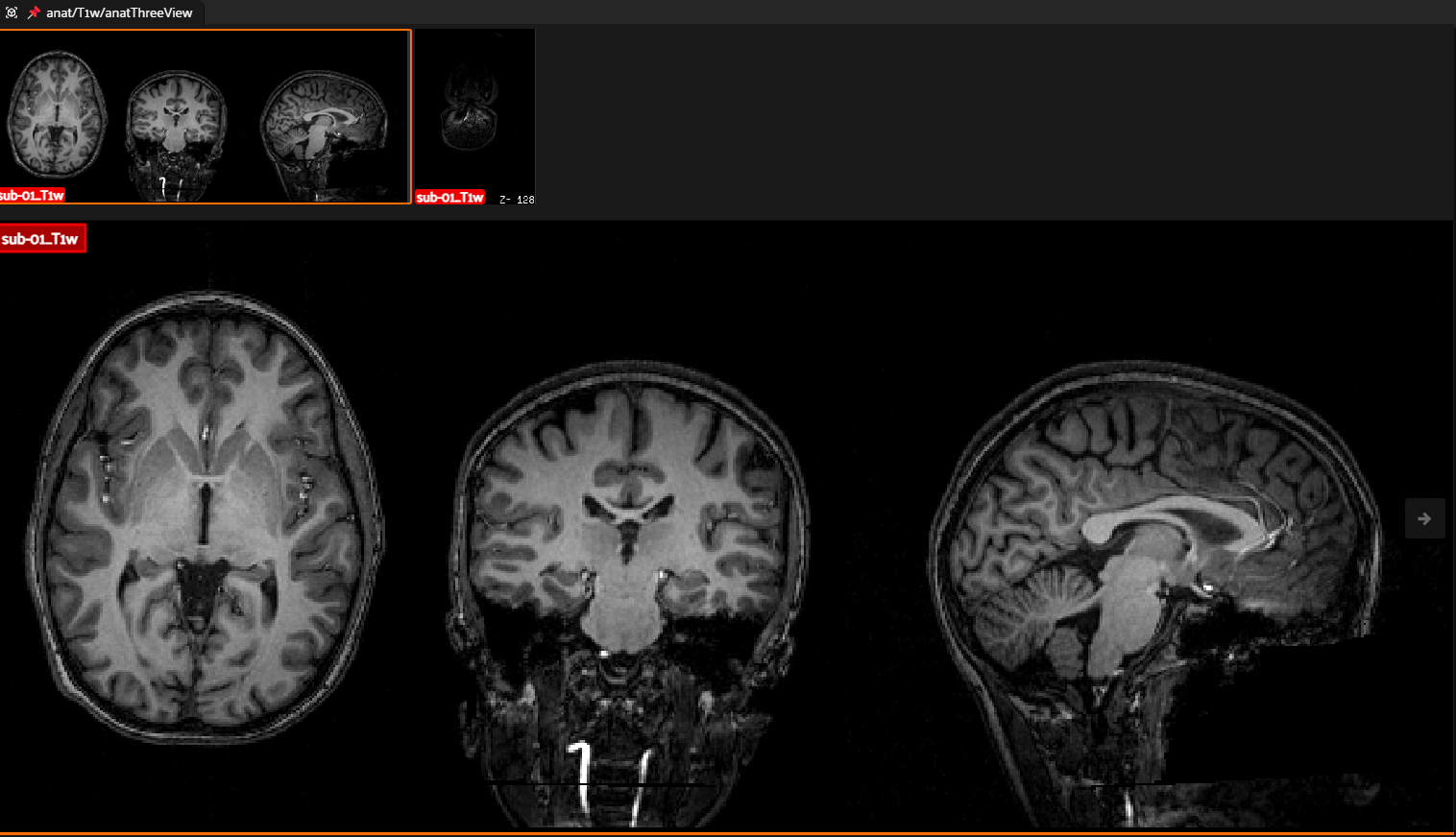
Diffusion
- QSpace shells - visualization of diffusion gradients in Q-space
- DWI per shell - video visualizing diffusion volumes by gradient strength
- Signal per volume - 2-panel video, visualizing diffusion MRI volume with associated average signal per volume
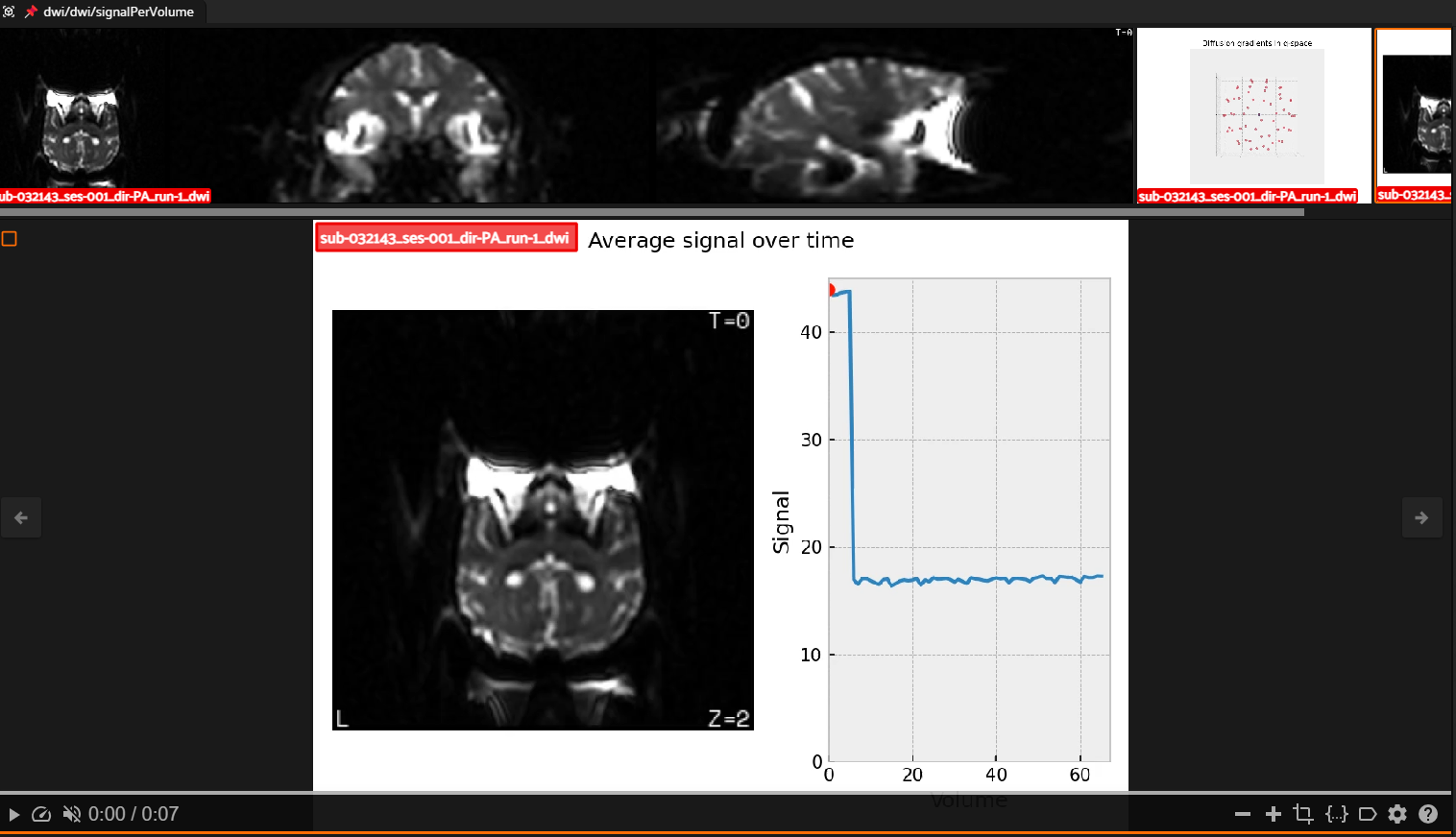
Functional
- Carpet plot - Visualization of carpet plot for functional data
- Mean / std - Visualization of mean and standard deviations of functional data
Overlaying of multiple volumes is also possible (e.g. to visualize masks, registration, etc.)
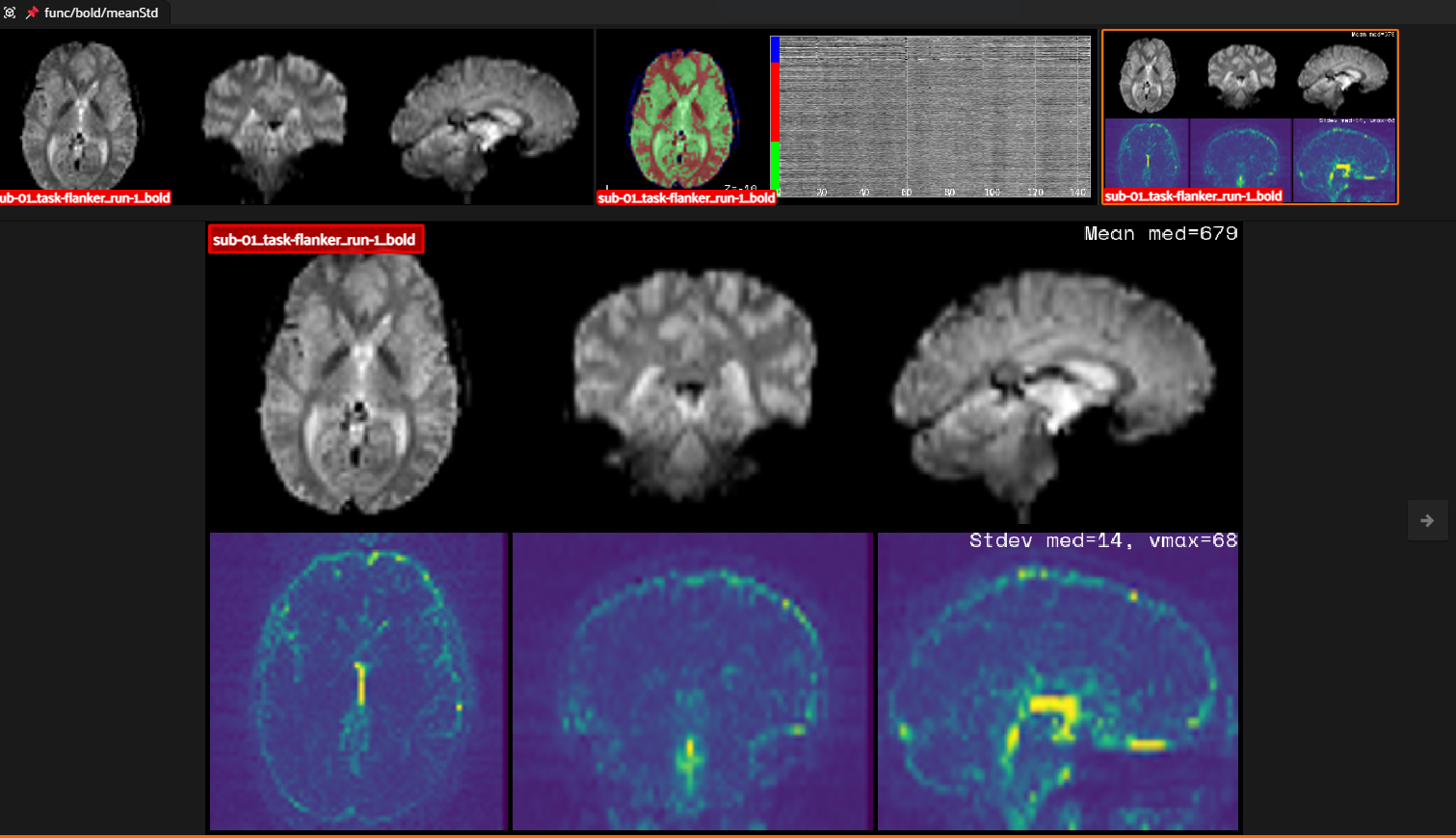
note
These are only some of the possible visualizations. Additional visualizations can be generated - see advanced usage for more details.
Metrics
NiftyOne can also aggregate QC metrics associated with each participant.
note
Currently, NiftyOne expects this to follow similarly to MRIQC group outputs. That is, a single tab-separated file with the following file name pattern: group_<suffix>.tsv, where <suffix> is associated with the BIDS entity (e.g. T1w). Each column is a separate QC metric, and each row is an individual participant.
For an example QC file, see the included QC metrics in the test dataset.
Usage
The follow section of the book contains information about hte various NiftyOne workflows, executing NiftyOne both on local machines and via containers. Additionally, there includes a sub-section on advanced NiftyOne usage.
Command line interface (CLI)
The following can also be seen by running niftyone -h in your terminal.
Below are all arguments of the NiftyOne CLI, separated by analysis level. In most cases, only the required arguments are needed.
usage: niftyone bids_dir output_dir analysis_level [options]
NiftyOne is a comphrensive tool designed to aid large-scale QC of BIDS datasets through
visualization and quantitative metrics.
positional arguments:
bids_dir Path to BIDS dataset
output_dir Path to output directory
analysis_level Analysis level
options:
-h, --help show this help message and exit
--overwrite, -x Overwrite previous results
--verbose, -v Verbose logging.
participant level options:
--participant-label LABEL, --sub LABEL
Participant to analyze (default: all)
--index PATH Pre-computed bids2table index path (default: {bids_dir}/index.b2t)
--qc-dir PATH Path to pre-computed QC outputs
(default: {bids_dir}/derivatives/mriqc)
--workers COUNT, -w COUNT
Number of worker processes. Setting to -1 runs as many processes as
there are cores available. (default: 1)
group level options:
--ds-name DATASET Name of NiftyOne dataset.
launch level options:
--qc-key LABEL Extra identifier for the QC session
For more information about the different analysis levels, see the workflows page.
Workflows
NiftyOne contains 3 primary analysis workflows.
Participant
The participant-level workflow can be the most time-consuming process, with image generation performed here.
Group
The group-level aggregates generated images for the platform. Additionally, if available, QC metrics are also aggregated during this workflow.
Launch
The launch-level workflow performs the simple task of launching the visualization platform. If successful, a local IP and forwarded port will be provided to connect to the platform on your local web browser.
Local
To use NiftyOne locally, first follow installation instructions. Once installed, NiftyOne can be initiated from the terminal.
note
Pre-computing a bids2table index path for a dataset is not required, but recommended.
1. Generating figures
We'll start by generating figures using the participant level workflow:
niftyone bids_dir output_dir participant --verbose
2. Aggregating data
Once figures are generated, we can aggregate figures (and QC metrics if available). For this example, we'll assume there are only figures. Additionally, we'll give the dataset a unique name - if one is not provided, it will assume this from the bids directory.
niftyone bids_dir output_dir group --ds-name example --verbose
Launching applicaiton
Finally, we can launch our application with the dataset by including the dataset name we used in the previous step.
niftyone bids_dir output_dir launch --ds-name example
If successfully launched, a message should appear in the terminal:
App launched. Point your web browser to http://localhost:5151
To exit, close the App or press ctrl + c
Enter the address in your web browser of choice to launch the application.
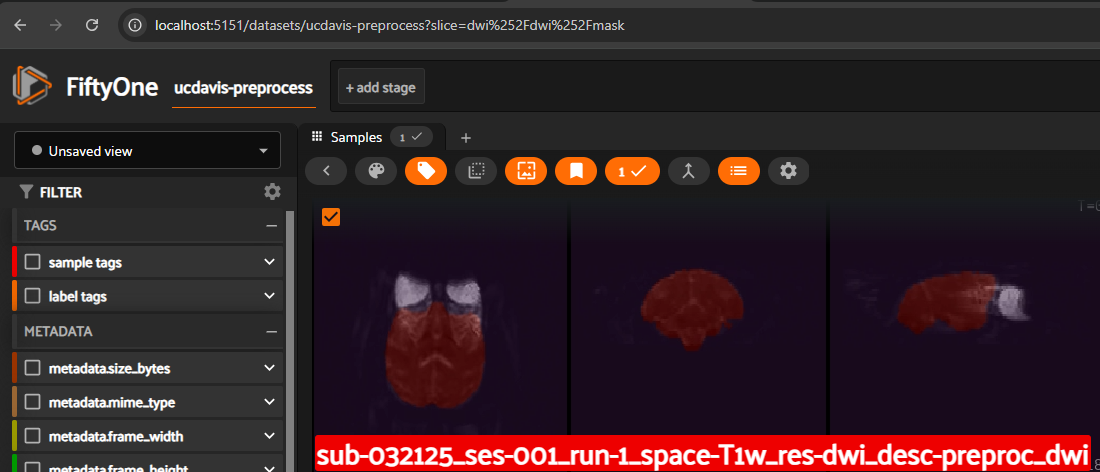
Container
Using NiftyOne via a container (e.g. Docker, Singularity), is similar to using NiftyOne locally. There are a few additional flags required.
NiftyOne uses a hidden .fiftyone directory stored in the home directory
(e.g. /home/user/.fiftyone) This directory needs to be writable
and mounted with the appropriate container flag.
Docker
First download the container, replacing <TAG> in the following
command with the version to be pulled:
docker pull ghcr.io/childmindresearch/niftyone:<TAG>
To use NiftyOne with Docker, the host network also needs to be made available to be able to pass the launched application. Rather than executing each workflow with individual Docker commands, it is recommended to shell into the container and call each command:
docker run -it \
-v "/home/user/.fiftyone:/.fiftyone:rw" \
--network host \
childmindresearch/niftyone:<TAG>
Once you are shelled into the container, you can follow the same instructions as if you are running NiftyOne locally.
Advanced
The following pages provide advanced usage instructions. These include things like running NiftyOne remotely, sharing QC results, etc.
Remote
NiftyOne can also be launched remotely (e.g. on a cluster). To use NiftyOne remotely, first follow either the local or container usage instructions with your remote server instructions (e.g. compute node if required). Once NiftyOne is launched, a (multi-layered) port forward will need to be set up from your local machine to the remote server:
Single-layer port forwarding
The follow provides an example of a single-layer port forward:
HOST=hostname # Name of the remote server (not the full address)
PORT=5151 # Assume port 5151 is available, change this as needed
ssh -L ${PORT}:localhost:${PORT} ${USER}@remote.server.com
note
-L ${PORT}:localhost:${PORT}maps the variable$PORTon your local machine to the same port on the remote serverlocalhost(relative toremote.server.com)
From here, point the web browser on the local machine (e.g. your computer) to
localhost:${PORT}.
Multi-layered port forwarding
The follow provides an example of a two-layer port forward (chain the command as needed for more layers):
HOST=hostname # Name of the remote server (not the full address)
PORT=5151 # Assume port 5151 is available, change this as needed
ssh -L ${PORT}:localhost:${PORT} ${USER}@remote.server.com ssh -L ${PORT}:localhost:${PORT} -N $HOST
note
ssh -L ${PORT}:localhost:${PORT} ${USER}@remote.server.comestablishes an SSH connection to the intermediate server while forwarding the portssh -L ${PORT}:localhost:${PORT} -N $HOSTforwards port from intermediate server to target remote host$HOST, with-Nto keep the session open solely for port forwarding
From here, point the web browser on the local machine (e.g. your computer) to
localhost:${PORT} as before.
Sharing QC annotations
NiftyOne enables users to interactively create QC annotations as tags within the application.
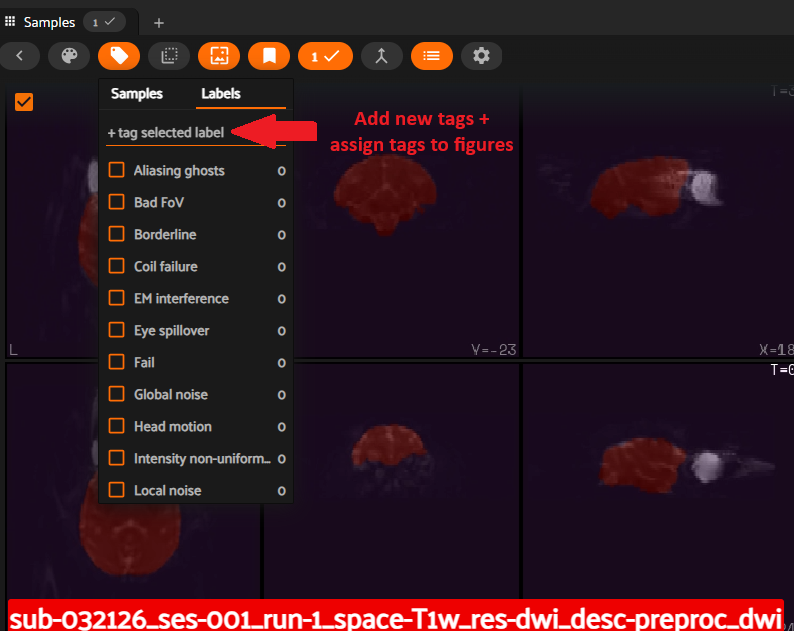
Annotations are saved to a JSON file when the application is closed, allowing QC
annotations to be easily shared with others. The JSON file can be found in the output
directory at output_dir/QC/<dataset_name>_tags.json.
Examples
This page provides example configurations to assist with figure generation. These examples are designed for use with the participant workflow. Additional figures can be generated by modifying configurations as needed.
Anatomical
The configuration below generates two views for anatomical T1-weighted (T1w) images.
queries:
t1w: &t1w datatype == 'anat' & suffix == 'T1w' & ext == '.nii.gz'
figures:
anat:
queries:
- *t1w
views:
three_view:
figure: anatThreeView
slice_video:
axis: 2
note
&t1wdefines a reusable YAML variable that can be referenced with*t1w- The query identifies all T1w images in compressed NIfTI format - it is important to ensure queries only filters only those volumes to visualize
- Keys under views correspond to keyword arguments for view-generating functions
Diffusion
The configuration below generates views for diffusion weighted (DWI) images in the same space as T1w images (for overlays). It also assumes there are 3D non-diffusion weighted (B0) images.
queries:
dwi: &dwi datatype == 'dwi' & space == 'T1w' & res == 'dwi' & desc == 'preproc' & suffix == 'dwi' & ext == 'nii.gz'
dwi_mask: &dwi_mask datatype == 'dwi' & space == 'T1w' & res == 'dwi' & desc == 'preproc' & suffix == 'mask' & ext == 'nii.gz'
b0: &b0 datatype == 'dwi' & space == 'T1w' & desc == 'avg' & suffix == 'b0' & ext == 'nii.gz'
t1w: &t1w datatype == 'anat' & run == 1 & suffix == 'T1w' & ext == 'nii.gz'
join_entities:
default: &default ["sub", "ses", "run"]
figures:
dwi:
queries:
- *dwi
views:
three_view_video:
dwi_mask:
queries:
- *dwi
- *dwi_mask
join_entities: *default
views:
three_view_video:
figure: "mask"
registration:
queries:
- *b0
- *t1w
join_entities: ["sub", "ses"]
views:
three_view:
overlay_cmap: "hot"
figure: "registration"
note
join_entitiesdefine which BIDS entities queries should match
Contributing
If you are looking to contribute, we recommend cloning the repository locally:
git clone https://github.com/childmindresearch/niftyone <local_directory>
cd <local_directory> # Navigate to local copy of repository
Dependencies
niftyone relies on a number of internal (python) and external (system) dependencies in
order to build a platform for bulk visualization of large-scale neuroimaging datasets.
The primary external dependency is FFmpeg - installation instructions can be found on
their website. Internal dependencies are listed in the pyproject.toml file of the
repository, with specific development versions listed in the requirements.txt file -
any version updates will also be reflected in this file.
Development environment setup
To setup the development environment, first ensure external dependencies are installed.
tip
It is recommended to setup a virtual environment to install internal dependencies and for stability.
python -m venv <venv_directory>
source activate <venv_directory>/bin/activate
Internal dependencies can be installed using pip:
pip install -e .\[doc,dev,test\]
To ensure the installation was successful, try running the niftyone command:
niftyone -h
Code formatting
niftyone uses pre-commit, as well as a Github action workflow to check for and address formatting issues.
These use the following:
ruff- formatting and lintingmypy- type checkinglanguage-formatters-pre-commit-hooks- pretty format YAML and TOML filespre-commit-hooks- fix string casing, format JSON files
To install the pre-commit configuration, run the following:
pre-commit install
Adding features / fixing bugs
To contribute a change to the code base, checkout a new branch from the main branch and then make your changes.
git checkout -b feature/your-feature-name main
Testing
While all new contributions will be tested, testing can also be done locally making use of the same dataset, ds000102, available as a sub-module in the testing directory. To download the sub-module:
git submodule update --init --recursive
Unit tests can be performed via pytest:
pytest --cov-report term-missing --cov src/ tests/ -s
note
niftyone workflows can also be tested by calling them directly using the datasets as
the <bids_directory> input and setting a separate <output_directory>
niftyone tests/data/ds000102 /tmp/niftyone_test participant
Pull requests
Once you have made your changes and are ready to contribute, follow the steps to submit a pull request:
-
Push your changes back.
git push -u origin feature/your-feature-name -
Create a pull request to merge your branch into the main branch. Provide a clear description of your changes in the pull request message.
Guidelines
- Write clear and concise commit messages.
- Test your changes thoroughly before submitting a pull request
- If the pull request adds functionality, the documentation should also be updated.
important
Contributed code will be licensed under the same license as the rest of the repository. If you did not write the code yourself, you must ensure the existing license is compatible and include the license information in the contributed files, or obtain permission from the original author to relicense the contributed code.
It is okay to submit work-in-progress and seek feedback - you will likely be asked to make additional changes or asked clarification questions.
Review process
All pull requests will undergo a review process before being accepted. Reviewers may provide feedback or request changes to ensure the quality of the codebase.
Frequently Asked Questions (FAQ)
-
Where can NiftyOne be installed?
NiftyOne can be installed both locally and on a remote serve. If NiftyOne is installed on a server, the output can be viewed from a local web browser after port forwarding.
-
I am getting the following error:
/home/user/.../mongod: error while loading shared libraries.Try to reinstall
mongoand / or re-creating the virtual environmentNiftyOneis installed in. -
I am getting the following error:
OSError: You must have fiftyone>=0.22.1 installed in order to migrate from v0.22.1 to v0.21.6, but you are currently running fiftyone==0.21.6.Try re-installing
fiftyone/niftyone. -
I am getting an error about connection failure to port 5151.
The port 5151 is likely already being used by another application - try incrementing the port number to 5152, 5153, etc.
Version
This document book provides details on the latest version of the tool. To reference
previous versions, please refer to the appropriate tag in the
Github repository - the pages of
the book can be found in the docs/src/ directory.
module niftyone
Large-scale neuroimaging visualization using FiftyOne.
Global Variables
- figures
- metrics
- runner
module niftyone.analysis_levels
Analysis-level workflows.
module niftyone.analysis_levels.group
Group analysis-level.
Global Variables
- TAGS
- IMG_EXTENSIONS
function group
group(
bids_dir: str | os.PathLike,
out_dir: str | os.PathLike,
ds_name: str | None = None,
qc_key: str | None = None,
overwrite: bool = False
) → None
Collects samples into a FiftyOne dataset and exports to the output directory.
module niftyone.analysis_levels.launch
Launch analysis-level.
function launch
launch(
bids_dir: str | os.PathLike,
out_dir: str | os.PathLike,
ds_name: str | None = None,
qc_key: str | None = None
) → None
Launch FiftyOne application to visualize a dataset.
module niftyone.analysis_levels.participant
Participant analysis-level.
function load_config
load_config(config: pathlib.Path | None) → dict[str, Any]
Load configuration file describing figures to be generated.
function participant
participant(
bids_dir: pathlib.Path,
out_dir: pathlib.Path,
sub: str | None = None,
index_path: pathlib.Path | None = None,
qc_dir: pathlib.Path | None = None,
config: pathlib.Path | None = None,
workers: int = 1,
overwrite: bool = False,
verbose: bool = False
) → None
Generate visualization images.
module niftyone.cli
Command line interface (CLI) utilities.
class NiftyOneArgumentParser
NiftyOne CLI parser.
method NiftyOneArgumentParser.__init__
__init__() → None
method NiftyOneArgumentParser.parse_args
parse_args(args: collections.abc.Sequence[str] | None = None) → Namespace
Parse command-line arguments.
module niftyone.figures
Figure factories for creating visualizations.
Global Variables
- factory
- dwi
- func
- multi_view
module niftyone.figures.dwi
Factories associated with diffusion visualizations.
class QSpaceShells
Visualize diffusion gradients in Q-space.
class DwiPerShell
Visualize diffusion in ascending order of diffusion gradient strength.
class SignalPerVolume
Visualize average signal per volume.
module niftyone.figures.factory
Factory for creating different figures.
Global Variables
- view_registry
function register
register(name: str) → Callable
Register view be callable in figure generation pipeline.
function create_view
create_view(
view: str,
view_kwargs: dict[str, typing.Any] | None,
join_entities: list[str],
queries: list[str]
) → View
Create a registered view.
function create_views
create_views(config: dict[str, typing.Any]) → list['View']
Create selected views dynamically from config.
class View
Base class for a View.
method View.__init__
__init__(
queries: list[str],
join_entities: list[str] | None,
view_kwargs: dict[str, typing.Any]
) → None
method View.create
create(
records: list[pandas.core.series.Series],
out_dir: pathlib.Path,
overwrite: bool
) → None
Create and save figure from a list of relevant records.
module niftyone.figures.func
Factories associated with functional visualizations.
class CarpetPlot
Visualize carpet plots of functional data.
class MeanStd
Visualize mean and standard deviations of functional data.
module niftyone.figures.multi_view
Factories associated with multiple views.
class ThreeView
Visualize static image in three orientations (coronal, axial, sagittal).
class SliceVideo
Visualize along single chosen orientation of an image volume.
class ThreeViewVideo
Visualize image volume along three orientations (coronal, axial, sagittal).
module niftyone.metadata
Utilities for handling metadata associated with dataset or application.
Global Variables
- tags
module niftyone.metadata.bids
Utilties for handling BIDS dataset associated metadata.
function make_dataset_description
make_dataset_description(out_dir: pathlib.Path, overwrite: bool) → None
Create dataset_description.json for BIDS dataset.
module niftyone.metadata.tags
Utilities for handling NiftyOne tags.
Global Variables
- TAGS
class GroupTags
QC tags for individual data acquisitions.
Interfaces between FiftyOne datasets and pandas DataFrames, CSV, JSON.
method GroupTags.__init__
__init__(tags_dict: dict[str, typing.Any]) → None
method GroupTags.apply
apply(dataset: fiftyone.core.dataset.Dataset) → None
Apply tags to a given FiftyOne dataset, overwriting existing tags.
method GroupTags.equals
equals(other: 'GroupTags') → bool
Assert two groups of tabs are equal.
classmethod GroupTags.from_csv
from_csv(path: str | pathlib.Path) → GroupTags
Extract tags from csv.
classmethod GroupTags.from_dataset
from_dataset(dataset: fiftyone.core.dataset.Dataset) → GroupTags
Extract tags from a FiftyOne dataset.
classmethod GroupTags.from_df
from_df(df: pandas.core.frame.DataFrame) → GroupTags
Extract tags from datafame.
classmethod GroupTags.from_json
from_json(path: str | pathlib.Path) → GroupTags
Extract tags from json file.
method GroupTags.to_csv
to_csv(path: str | pathlib.Path) → None
Save tags to csv.
method GroupTags.to_df
to_df() → DataFrame
Convert tags from dict to pandas dataframe.
method GroupTags.to_json
to_json(path: str | pathlib.Path) → None
Save tags to json.
module niftyone.metrics
Utilities for handling QC metrics.
function create_niftyone_metrics_tsv
create_niftyone_metrics_tsv(
record: pandas.core.series.Series,
entities: bids2table.entities.BIDSEntities,
out_dir: pathlib.Path,
qc_dir: pathlib.Path,
overwrite: bool = False
) → None
Filter for metrics associated with record (image).
module niftyone.runner
Handles coordination to generate figure and extract metrics via workflow Runner.
class Runner
Runner class to process participants dynamically.
method Runner.__init__
__init__(
figure_views: list[niftyone.figures.factory.View],
out_dir: pathlib.Path,
qc_dir: pathlib.Path | None,
overwrite: bool
) → None
method Runner.create_figures
create_figures() → None
Generate figures from dataset.
method Runner.update_metrics
update_metrics() → None
Generate / update QC metrics for dataset.






